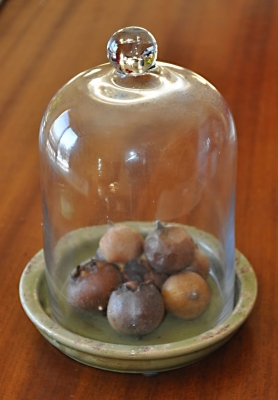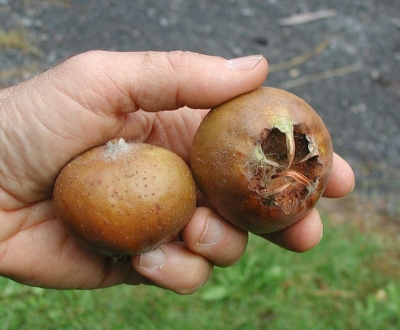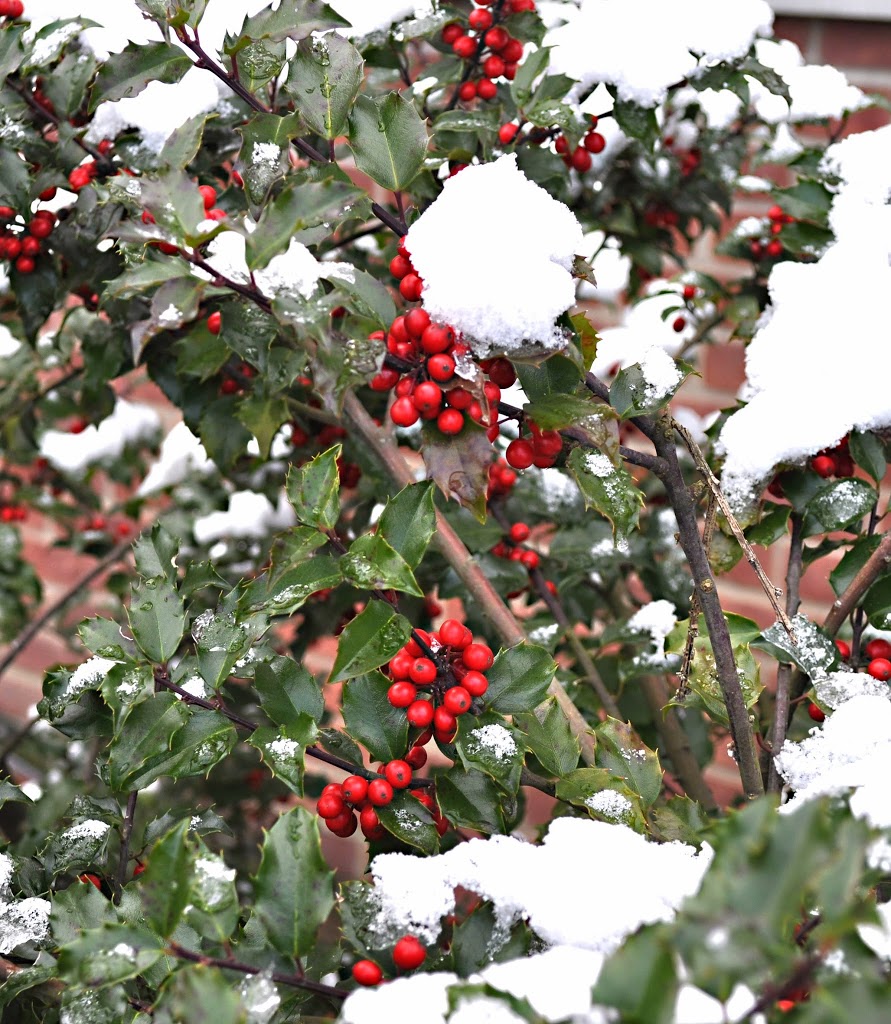Today’s fruit du jour is medlar (Mespilus germanica), one of the most-disgusting-looking fruits you could imagine. Don’t stop reading! Medlar was a popular fruit in the Middle Ages, and with good reason. Charlemagne was so taken by this fruit that he decreed that it be planted in every town he conquered. Medlar needs some contemporary pr.
Let’s get those bad looks out of the way. Picture a small apple with a rough, russeted skin and the calyx end — the end opposite the stem — flared open. Not very pretty, eh? That homely appearance gave rise to
some not-so-complimentary nicknames. “Open-arse” fruit, for example, by Chaucer. Or, from Shakespeare, more discretely, “open-etcetera.”
Ugliness, for medlars, is not just skin deep. When harvested, which was a few weeks ago here, the fruits are white and rock hard within, and not ready for eating. The fruit must be bletted, or ripened, a couple of weeks or more. I blet my medlars by setting them on the cool, north windowsill facing my kitchen sink. With the woodstove at full tilt, the air at the windowsill might still be too dry for best bletting, so I also have a few fruits bletting beneath a small bell jar in another cool part of the kitchen. A wrinkling, dark skin tells me that bletting is complete. At this point the flesh has experienced a dramatic transformation — to brown mush.
I put all that ugliness behind me and taste that brown mush. Delicious! Something like very rich applesauce with hints of wine. I’ve only eaten them straight
up. They allegedly also cook up into delicious tarts, jellies, “fools,” and the like. Here’s a simple recipe for a tart, dating back to 1660, from Robert May’s The Accomplisht Cook: “Take medlars that are rotten, strain them, and set them on a chaffing dish of coals, season them with sugar, cinamon and ginger, put some yolks of eggs to them, let it boil a little, and lay it in a cut tart; being baked scrape on sugar.”
(For a once popular fruit, medlar has had its share of pejoratives. “Rotten,” in the above recipe, means bletted. But many fruits, including European pears and avocados, need to be harvested unripe to ripen off the plant. Admittedly, few are brown mush when ready to eat.)
————————————————————–
So much for medlar’s bad looks and good flavor. Let’s take a good look at the plant itself.
Those ugly fruits ripen on a very attractive, small tree that never reaches more than about eight feet high or a spread of equal width. It’s a year ‘round beauty, even now, leafless, with its craggy branches and light brown bark. In spring, in contrast to many other fruit trees, the leaves unfold before the blossoms; each
blossom, opening singly and with white petals like a wild rose (a relative), is then framed by a whorled backdrop of forest-green leaves.
The tree is also self-pollinating, so does not need a companion to set fruit. Small size, beauty, and ability to perform solo make a medlar tree perfect for a small yard. One tree, then, doubles as your ornamental plant and your fruit tree.
————————————————————-
Pests can be a big bugaboo when growing tree fruits. The best way to deal with pests is to avoid them, and the best way to avoid them is to grow kinds or varieties of fruits naturally resistant to pests. That’s one reason I suggest against growing apples pretty much anywhere east of the Rocky Mountains. (Two of apples most significant pests, plum curculio and apple maggot, are absent from many areas of the West.) Nectarines, peaches, apricots, and plums similarly suffer from serious insect and disease problems, again, especially east of the Rocky Mountains.
You may wonder, then: What’s left to grow? Pears, for one. Also, a slew of other tree fruits that are not well-known, fruits such as medlar, pawpaw, persimmon, cornelian cherry, raisin tree, mulberry, and Asian
 |
| Bletting medlars |
pear. These uncommon fruits all have excellent flavor and few or no pest problems (and play the leading roles in my book Uncommon Fruits for Every Garden). They also demand little expertise or time in pruning as compared with some of the common tree fruits.
Not that biting into a fresh-picked, good variety of well-grown apple or peach isn’t a heavenly experience. And not that the occasional tree of such fruits some years bears a decent crop without trouble. But it pays to play the averages and proceed with eyes wide open. What are the chances for a good harvest and how much effort (and learning) will be devoted to upping the odds?









What’s the purpose of the bell jar?
Regards & best of the season to you,
Mike
To maintain humidity. I’m not sure if it’s really needed, or better.
It’s probably not a bad idea if the bletting takes a while and there is dry winter air in the house.
Any chance of getting seeds as soon as you open the fruit? I’ve got Royal and Nottingham that were gifted to me grafted onto Marron and need to get them onto separate rootstocks. Ultimately , I’d like to get them onto medlar seedling rootstock. Germination is difficult but maybe I’ll get lucky.
Regards & all the best in the New Year,
Mike
Also, do you know of a good supplier of medlar trees? Thanks!
Here’s the list of medlar sources from the appendix of my book UNCOMMON FRUITS FOR EVERY GARDEN:
•Edible Landscaping Nursery, Route 2, Box 77, Afton, VA 22920, 800-524-4156; http://www.eat-it.com
•Hidden Springs Nursery, 170 Hidden Springs Lane, Cookeville, TN 38501, 931-268-2592
•One Green World, 28696 South Cramer Road, Molalla, OR 97038, 877-353-4028; http://www.onegreenworld.com
•Raintree Nursery, 391 Butts Road, Morton, WA 98356, 360-496-6400; http://www.RaintreeNursery.com
I’ve ordered a medlar variety called “Puciomol” from Hidden Springs Nursery that will arrive this spring and I can’t wait. I live in Ohio and have had my share of frustration with apples, plums and cherries. If plums weren’t so good I’d probably have given up already. But I’ve gotten to the point where paw paws, juneberries and gooseberries are the most productive fruits in my garden.
I ordered a medlar variety called “Puciomol” from Hidden Springs that will be delivered this spring and I can’t wait to plant it. I live in Ohio and have had my share of disappointment with apples and plums.
I agree about the plums. I grow Imperial Epineuse, and when I get a crop, they are the most delicious plums ever. The “uncommon fruits,” though always yield good crops.
Except that is not how you harvest/eat a medlar fruit. You wait for the first frost to pick them once the we’re frost bitten, they are perfect, soft, sweet and oh so amaizing!!
That’s another way of eating them, which I’ve also tried. I find that they are drier left outdoors.
This fruit is very popular and common in fall season in northern Iran region called Guilan Province, next to Caspian Sea.
“Very popular”?! Interesting.
Can the wood of the medlar tree be used for smoking or grilling?
Thanks.
I have no idea. But it is closely related to apple and pear.
In Cyprus us Turks call this fruit ‘muşmula “. Its a popular fruit people eat it as it comes. I would never have call this fruit or any other fruit ugly.
What is know for ZUZULE FRUIT. I had this fruit in Croatia. Small but very tasty. Where did it originated from.
Quoting from my book “Uncommon Fruits for Every Garden”: There is some question as to the original home of the medlar, for dense thickets of scraggly and thorny wild medlars now are naturalized over much of Europe. The greatest diversity amongst wild medlars, suggesting a possible point of origin for this plant, is along the west coast of the Caspian Sea. But leaf impressions of the medlar have been reported in interglacial deposits in the former East Germany, lending support to Linnaeus’s choice of germanica for the specific epithet.
Hi Lee! Love your work! I’m curious if you know if Medlar’s can be planted where we just cut down black walnuts. I can’t find anything on juglone effecting or not effecting them.
I have no idea but I expect that it would respond the same as would apple, pear, or other close relatives.
I’m on the West Coast of Canada and will be going a-hunting for a medlar tree soon. Do You know of a source on southern Vancouver Island?
Sorry, no. But there are plenty of mail order sources. A variety of any plant should perform the same no matter the location of the nursery.